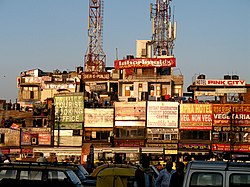Paharganj
| Paharganj | |
|---|---|
| Neighbourhood | |

Paharganj hotels and restaurants, across New Delhi Railway Station
|
|
| Location in Delhi, India | |
| Coordinates: 28°38′42″N 77°12′47″E / 28.64500°N 77.21306°ECoordinates: 28°38′42″N 77°12′47″E / 28.64500°N 77.21306°E | |
| Country |
|
| State | Delhi |
| District | North Delhi |
| Government | |
| • Body | Municipal Corporation of Delhi |
| Languages | |
| • Official | Hindi, English |
| Time zone | IST (UTC+5:30) |
| Lok Sabha constituency | New Delhi |
| Vidhan Sabha constituency | Paharganj |
| Civic agency | Municipal Corporation of Delhi |
Paharganj (Hindi: पहाड़गंज, Urdu: پہاڑ گنج, Punjabi: ਪਹਾੜਗਂਜ, literally 'hilly neighbourhood') is a neighbourhood of Central Delhi, located just west of the New Delhi Railway Station. Known as Shahganj or King's ganj or market place during Mughal era, it is one of the three administrative subdivisions, of the Central Delhi district, of the National Capital Territory of Delhi, with the other two being, Darya Ganj and Karol Bagh.
Known for its concentration of affordable hotels, lodges, restaurants, dhabas and a wide variety of shops catering to both domestic travellers and foreign tourists, especially backpackers and low-budget travellers, it has become particularly popular as a haunt for international cuisine.
In the years after its establishment in 1638, Shahjahanabad, the capital of the Mughal Empire under Shah Jahan, was no longer contained within the walled city, it soon spilled into surrounding areas, stretching into miles at each end, where half of its population stayed. By 1739, the suburbs covered 1800 acres and included areas like Mughalpura, Sabzimandi, Paharganj and Jaisingh pura. One of the largest and most important suburban mohalla of the Walled city of Delhi, and located just outside the Ajmeri Gate of the Walled city, Paharganj was one of five main markets of Delhi, and the only one outside the walled city. Also, it was the principal grain market of the city in the 18th century, where grain was ferried, across Yamuna river, from wholesale markets and warehouses in Patparganj and Shahdara. Just outside the Ajmeri Gate was the custom house of the emperor, for collecting taxes. Between Paharganj and Akbarabadi gate of the walled city was Shahganj, another wholesale market, while on the other side towards Jantar Mantar was Raja Bazar. In fact Paharganj was also referred as Shahganj or King's ganj or market place during Mughal era, it gets its present name 'Paharganj', literally meaning Hilly neighbourhood, owing to its proximity to the Raisina Hill, where the Rashtrapati Bhavan stand today. Till, 1857, neighbourhoods like Paharganj, Kishenganj, and Pahari Dhiraj, were separate pockets which in the following years grew and merged, for example Pahari Dhiraj merged into Sadar Bazaar.
...
Wikipedia

